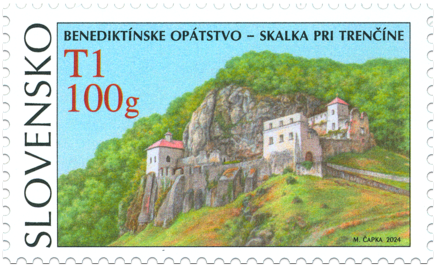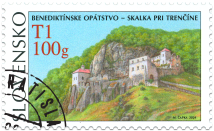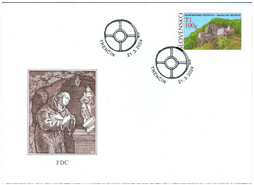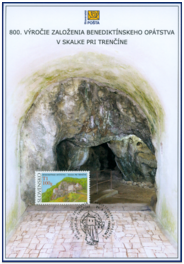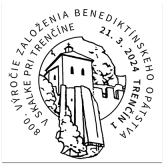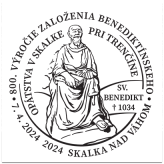813 Date of issue
21.03.2024 Face value
1.50 € Sell price
1.50 €
The ruins of this smallish monastery on the right bank of the Váh, just below the steep walls of a limestone crag, are located in an area called Veľká Skalka. The monastery buildings were created as an extension to a cave in the rock massif, which formed the cult centre of the compound. Tradition has it that the cave was inhabited by Benedict, a monk from the Zobor Monastery, who lived there as a hermit in the 11th century – perhaps in the early 1030s. He followed the example of his teacher, Svorad, who also lived as a hermit, probably in a cave near the monastery on Zobor Hill. We know about the Church of St. Benedict from a mention of it in 1208, it was built in Skalka before the establishment of the abbey. However, it is not certain if it was situated in exactly the same place as the monastery (it could also have been located in the area of Malá Skalka or on the hillock above the monastery called Chochel). The Benedictine monastery in Skalka was established, in tribute to St. Benedict, hermit and All Saints, by the Archbishop of Nitra, James, in 1224. By 1527 it was probably owned by the Benedictines. There is a mention of a local abbot from 1527 – a Benedictine (after a period of decline, the Jesuits renewed the compound and the life of the monastery after they acquired it in 1644). Sadly, the monastery fell into ruin and there is little information about its medieval appearance. The only part of the former monastery, that can still be used today, is a three-floor chapel. Squeezed between the crag and a fence at the eastern tip of the monastery, it is directly linked, on the third floor, to the hermit’s cave. The chapel has been rebuilt and reconstructed several times. The Baroque reconstruction that took place in 1717 was probably significant. A lateral wall within the top floor includes the torso of a late Romanesque portal. Although it was only placed here secondary to the construction, it is precious evidence related to the initial construction history of the monastery. Its morphology allows for the possibility that the stonemasons that took part in the construction of the Cistercian monastery at Velehrad in Moravia also worked on the monastery in Skalka. They might have been directly invited by the Archbishop of Nitra, James, to come to the Váh Region, who shortly after the establishment of the monastery in Skalka, also participated in the consecration of the monastic church at Velehrad in 1228. The ruins of the monastery include another medieval portal. It was walled into the crag, probably sometime at the turn of the 14th century. To this day, it forms the entrance to the cave through which you can enter the third floor of the chapel.
Bibiana Pomfyová
Show less© 2024 POFIS - Postal philatelic service. All rights reserved

